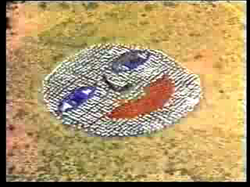
BA ethnic tail Market Day on an Embraer ERJ 145 In 1997 British Airways adopted a new livery. One part of this was a newly stylised version of the British Airways "Speedbird" logo, but the major change was the introduction of tail-fin art. Also known as the Utopia or world image tailfins, they used art and designs from international artists and other sources to represent countries on BA's route network. The signature of the artist was carried near the design on the tail.
The new corporate logo was created by the London-based design agency Newell and Sorrell, who also oversaw the implementation of the tailfin designs.
The German designs refer to the BA subsidiary Deutsche BA, and the Australian designs to the BA's alliance with Qantas.
Criticism
The adoption of this aircraft livery was seen as a move away from the traditional British image of the carrier. BA suggested that the previous "Landor Associates" scheme carried an air of arrogance and detachment, and insisted that the new tailfins were popular with international travellers. However, they were unpopular with many people in the UK, despite nine of the designs being inspired by either England, Scotland or Wales. Former Prime Minister Margaret Thatcher showed her displeasure at the designs by covering one of the new tailfins on a model 747 with a handkerchief. She declared, "We fly the British flag, not these awful things."
Virgin Atlantic took advantage of the controversy by applying a Union flag scheme to the front end of its aircraft. In their own 1999 relaunch, the flag was also applied to the vertical winglets of Virgin Atlantic's aircraft.
Safety concerns were also raised that the lack of a consistent tail design could lead to BA aircraft being mis-identified by controllers and other aircrew.[citation needed]
[edit]Review of use
While the majority of the designs were applied to a variety of aircraft models, one scheme (the stylised version of the Chatham Dockyard Union Flag) was used on Concorde only. By 1999, BA had repainted around 170 aircraft in its new colours but then Chief Executive, Bob Ayling, announced a review of this process. The aircraft already repainted would keep the new designs, but the remainder of the fleet (still showing the pre-1997 union flag design) would receive a variant of Concorde's Union Flag design. The announcement was timed to divert some attention from Virgin's relaunch.
Finally in May 2001 the new Chief Executive, Rod Eddington, announced the entire fleet would receive the new Union flag livery. Eddington argued that while an attempt to increase the airline's appeal was not a bad thing, the exercise hurt the image of the carrier among its core customers — those that are attracted by the British identity, which the ethnic tailfins diluted somewhat.
Liveries
Gallery
Animals and Trees on a Boeing 747-400 | Blomsterang on a Boeing 767-300 | Chatham Dockyard Union Flag on a Boeing 747-400 | Chelsea Rose on a Boeing 767-300 |
Delftblue Daybreak on a Boeing 767 | Koguty Lowickie on a Boeing 757-200 | Market Day on an Embraer ERJ 145 | Ndebele on a Boeing 737-400 |
Paithani on a Citiexpress Embraer ERJ 145 | Water Dreaming on an Embraer ERJ 145 | Waves and Cranes on a Boeing 767-300 | Waves of the City on an Embraer ERJ 145
|
List
British Airways World Art liveries
Name Summary Origin
Chatham Dockyard Union Flag Introduced on Concorde for relaunch, now the livery for entire fleet United Kingdom
Animals and trees Art of a tribe in the Kalahari Desert Botswana
Avignon Jim Avignon design, contemporary German art Germany
Bavaria/Edelweis German art Germany
Benyhone Anglicized Gaelic for "Mountain of the birds", a Scottish tartan design Scotland
Blomsterang/Flower Field Hearts and flowers Sweden
Blue Poole Pottery design England
British Blend Coffee cup design, result of New Britain competition, used on a single A320 United Kingdom
Chelsea Rose Representation of the English rose England
Colour Down the Side Abstract cornish art, used on a single Dash 8 of Brymon Airways (BA Citiexpress) England
Colum Anglicized Irish for "Dove": a Celtic design Ireland
Crossing Borders Egyptian scroll Egypt
Delftblue Daybreak Delft pottery design Netherlands
Golden Khokloma Representation of art on pottery and utensils Russia
Gothic/Calligraphy German art Germany
Grand Union By Christine Bass (artist and designer), result of a Sunday Times competition, based on traditional English canal boat art United Kingdom
Koguty Lowickie Polish artist's print of cockerels, peacocks and flower Poland
L'esprit Liberté Celebrating human rights movement International
La Pyramide du Louvre One aircraft painted with image of central courtyard of Louvre museum France
Nalanji Dreaming Aboriginal art, originally designed for Qantas Australia
Ndebele Martha Geometric art. By Martha Masanabo South Africa
Ndebele Emmly Similar to Ndebele Martha, by Emmly Masanabo South Africa
Paithani Textile print India
Pause to remember Poppy design, used around Remembrance Day. Now applied to fuselage United Kingdom
Rendezvous Chinese calligraphy Hong Kong
Spring Images of Romania Romania
Sterntaler/Bauhaus Antje Brüggemann's 3-D 'ceramic objects' art Germany
Teaming up for Britain Adopted for 2000 Summer Olympics, features British Olympic Association logo United Kingdom
Wunala Dreaming Like Nalanji Dreaming, this livery was designed for Qantas Australia
Water Dreaming Art representing northern Australian terrain Australia
Waves and Cranes/Nami Tsuru Montage of a Japanese artist's depictions of waves and cranes Japan
Waves of the City/Floating Simple and modern United States
Whale Rider From wood carving representing the whaling tradition of the artist's community Canada
Wings Representing seagulls in flight Denmark
Youm al-Suq Arab market Saudi Arabia
(source:wikipedia)

















